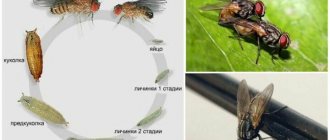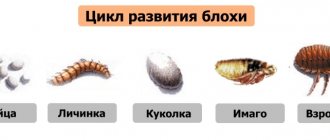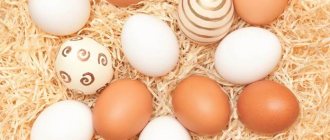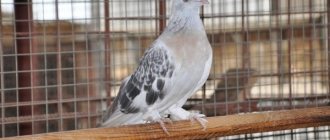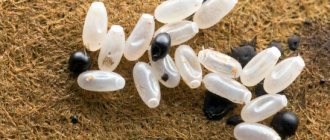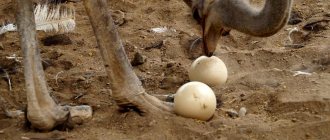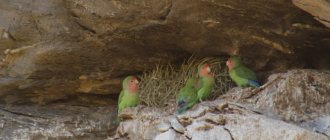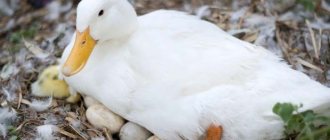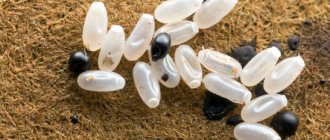Home » Articles about pigeons » How, when and where do pigeons lay eggs and hatch chicks?
City residents can only find out what pigeon eggs look like from a photo. Few people get to see the nests of sisars and their chicks in person. These birds find secluded places to breed. During the mating season, they usually settle down under the roofs of abandoned buildings, theaters, and attics, where they cannot be seen. That's why many people don't know when, how and where pigeons lay eggs and hatch their chicks.
Breeding pigeons
Like other birds, pigeons first lay eggs and then begin to hatch them. This is the only way to increase the bird population. To implement this process, 3 factors are important: a suitable partner, increased nutrition, and the presence of a nest.
In the wild, birds choose their own mates, but in captivity the breeder is responsible for breeding them. To successfully implement the process, for 60 days the birds are separated into different pens according to gender. During this time, the females will become sufficiently strong and rested to begin incubating eggs. You can begin work in this direction immediately after the thaw, in early spring. While the birds are in separate pens, the dovecote is cleaned and disinfected.
The next important step is arranging the nest. In ordinary life, pigeons choose places remote from humans for these purposes: on trees, roofs of houses, in abandoned buildings. In captivity, a person deals with this process independently, placing nests at a distance from each other, so that in the future there are no conflicts between females.
Fact! If the area to be laid is small, boxes with nests can be placed in several tiers and numbered.
How long does it take for chicks to hatch?
After the start of incubation, at least 16 days pass. The first chick in the brood appears from the first egg laid, the second - after 1 day. The day before hatching, the pigeons peck at the shell.
To make pecking easier, you can humidify the air in the dovecote by placing containers of water next to the nests.
You cannot help the chicks get out of the shell; you need to wait until the process ends naturally. For pigeons it can take 0.5-1 days.
If the chick never appears, it means it died, and you need to come to terms with this.
Despite the short incubation period, households need to prepare for the breeding season in advance. In the dovecote you need to place nests according to the number of pairs, put grass, straw, and twigs nearby so that the birds can build a nest.
In order for the pigeons to hatch at the same time and develop equally, the first egg laid must be taken out of the nest and a fake one should be placed. Store the egg at room temperature until the female lays the second one.
Then put it in the nest. When the females sit on the eggs, they cannot be disturbed, otherwise they may abandon the nest and the embryos will die.
How pairs are created
For successful mating of pigeons, it is necessary to take care of making suitable pairs for this. The first task is to distinguish a male from a female. To do this, it is enough to observe their behavior. During the mating season, males spread their bushy tails and walk around the “lady” they like in circles. At the same time, the female behaves much calmer and begins to bow her head down, as if submitting to fate.
If conflicts begin between individuals, it means that pair formation has not occurred - the female has rejected the male. To avoid such a nuance, a couple is made up, paying attention to the nature of the birds. For example, a docile female will suit an overly active male and vice versa.
Habitat, features
- Pigeons are quite widespread throughout the Earth. It was possible to establish that their original homeland was Europe or North Africa.
- In nature, these birds live for about 5 years, and domesticated individuals live up to 15 years. There is even evidence that pigeons have lived up to 30 years!
- The success of the mating process of pigeons determines whether the chicks will be healthy and whether it will be possible to breed a new breed.
- The first thing you need to find out is what pigeons are interested in, how they behave in nature, how they create pairs in order to reproduce.
Pairing
The process of fertilization can be natural (in the wild) or forced (in captivity). Breeders can also use the natural method by keeping birds of the same breed in a dovecote. Forced mating helps improve the quality of the existing population.
Natural mating is ultimately much more productive than forced mating, so the second option is used as a last resort.
Attention! Forced mating takes much longer than natural mating, and is often associated with various difficulties, failures, and the death of offspring.
General characteristics of the class
The progressive features of the organization include the following features.
- High level of development of the nervous system and therefore a wide variety of options
- Constant high body temperature, which is caused by intense metabolism.
- Compared to lower subtypes and classes of animals, birds have a more advanced reproduction mechanism, which is expressed in incubating eggs and feeding offspring.
- The presence of adaptive organs for flight and at the same time the ability to move on the surface of land, and in some species - the ability to swim and move along the water surface.
The above features of the class allowed these animals to spread throughout the globe.
Suitable age
Pigeons reach sexual maturity 6-7 months after their birth. This does not mean that birds can reproduce - at this age they are still actively growing, so they will not be able to breed healthy offspring.
Upon reaching 2 years of age, birds are completely ready to mate. Sexual activity continues for up to 10 years, but the number of viable eggs decreases every year. To obtain chicks of the desired breed, breeders forcefully mate young females with old males, but only if they are completely healthy. Otherwise, the clutch will be filled with non-viable eggs, or the bird embryos will die during the incubation process.
Hatching process
The female begins to incubate eggs after the entire expected number of eggs have hatched.
Temperature
The incubation temperature ranges from 36.1 degrees to 40.7. There is a difference between heating the upper part of the egg (where the female sits) and the lower part (which is at the bottom of the nest). It is 4-5 degrees.
Who hatches the eggs?
The dove does the incubation, but since pigeons are caring birds, the male also takes an active part in this process.
About a couple of times a day he replaces the female so that she can feed. He does this during the daytime. If the expectant mother cannot return to the nest in a timely manner, then the father begins to panic, emitting loud screams.
Number of eggs in clutch
2 weeks after mating, the female begins to sit in the nest, preparing to lay eggs. All breeds of pigeons produce on average no more than 3 eggs in several stages. First, the female lays the first egg, then rests, gains strength, and only after a few days gives birth to the rest. At this time, the first egg must be placed in an incubator, otherwise the embryo will not be able to survive.
Attention! Breeders for breeding birds use only individuals under 5 years of age.
Pigeon eggs are very durable, white, slightly creamy in color. They differ from the eggs of other birds by the characteristic sheen of the shell. Sometimes it seems that they are artificial.
Useful properties of the product
In many countries people eat pigeon eggs. They not only taste good, but are also extremely healthy. The calorie content of the product is low - 115 kcal per 100 g, which allows it to be classified as dietary. Pigeon eggs contain retinol, tocopherol, as well as vitamins D and B. The product is rich in microelements:
- iron;
- cobalt;
- iodine;
- potassium;
- gray;
- manganese;
- phosphorus.
You should not eat the eggs of wild pigeons, as birds living in their natural environment can be infected with infectious diseases. Some of them are dangerous to people.
The dietary product is recommended to be included in the diet of children, pregnant women and the elderly. Eating it has a beneficial effect on the organs of vision, kidneys, skeletal system, blood vessels, and prevents the formation of blood clots. The product can only be harmful to people with individual intolerance to egg whites, so it should be introduced into the diet of young children with caution.
- Related Posts
- What is the best way to feed pigeons?
- DIY dovecote: drawings
- wild pigeon
- Sulteprim for pigeons
- How to train pigeons
- Is it possible to eat pigeons
Laying a nest
Despite all the efforts of a person lining the bottom of the boxes with straw or hay, the birds still complete their nests on their own. To do this, you need to leave the necessary building material on the floor of the dovecote: thin, dry branches, some grass, feathers.
The male determines the location for the future nest, and only then shows it to the female. When the approval process has passed, the male begins to look for suitable materials and bring them to the female while she is engaged in construction work.
Pigeons should be released into the prepared area one at a time: first the older pairs, then the young ones. The reason is that the birds choose a familiar place for themselves, and if it is occupied, a conflict may arise.
Where are the little pigeons hiding from us?
A city dweller may be perplexed about the increase in the number of pigeons. After all, on the street he sees only adult birds.
This is partly due to the peculiarities of nesting: as a rule, pigeons build homes in places reminiscent of rocks and caves. In cities, nests are built under window sills, under bridges, on roofs.
Another reason is that pigeons do not leave the nest for 4-6 weeks after birth. They join the pack when they are already grown up.
How long do pigeons hatch eggs?
From the moment of laying to the hatching of the offspring, an average of 18 days pass. Poultry farmers prepare for this process in advance: they begin to intensively feed the pigeons and prepare a place for future nests.
2 months before the start of incubation, the mating season begins, during which the newly formed couple will be busy arranging their nest. To do this, they will need building material (branches, feathers, straw, grass), which the breeders must place inside the dovecote.
Birds reproduce very intensively - they lay eggs up to 8 times per year. The most optimal time for this is the end of spring, the beginning of summer, because before the onset of cold weather, the chicks must have time to get stronger, learn to fly independently and get their own food.
The appearance of chicks
A parrot egg weighs approximately 2.5 grams, and a newborn chick weighs even less - 2 grams. They hatch with the help of an egg crop, which is a seal on the beak. Having broken through the shell, the chicks find themselves outside, where they are completely helpless. They don't actually move, are blind and have no feathers. New parents feed them with semi-digested food, which is called goiter milk.
Adult parrots continue feeding the chicks for 2 months, then the babies become completely independent birds and begin to fly out of the nest.
It is important not to miss this moment - they are removed and the nest is removed. It is worth considering that a female weakened by breeding needs rest and peace.
What do the offspring of pigeons look like?
The little chicks look unassuming: they are completely bald, blind and helpless. In the first few days, the parents provide them with food around the clock so that the birds begin to actively grow. Feeding work is carried out with equal intensity by both males and females. Only in the first days the dove does not leave her children, and then joins the male.
Chicks eat almost everything: plant remains, grain, insects. True, all this is transported to them in crushed form. But their first food is a curd secretion secreted in the mother’s crop and called “bird’s milk.”
After 4 weeks, the chicks turn into young pigeons, ready for their first flights and the beginning of an independent life. After this time, the parents leave their nest, leaving the offspring to adapt to the new world on their own.
Fact! Small pigeons are very noisy, so it is not recommended to build nests for their parents near living quarters.
Why don't turkeys lay eggs?
Those farmers who have already dealt with keeping turkeys know firsthand about their capriciousness and tenderness. To achieve maximum egg production of a bird, it is necessary to create special conditions for it, provide high-quality care and nutrition.
If a turkey has a low level of egg production or it disappears altogether, there may be several reasons:
- You should not wait for egg-laying during molting - this is a period when all the body’s forces go to renewing feathers, but there is not enough for laying eggs. If after the end of this period egg production is restored, then everything is fine with the bird.
- A small number of eggs may be observed due to insufficient lighting in the house. It is recommended to set the daylight hours to at least 10 hours. To do this, the house must have at least one window + additional lighting, preferably fluorescent lamps. The best egg production is observed with 12–14 hour daylight hours.
- It may be too cold in the poultry house. In order for the bird to feel comfortable, the temperature in the place where the nests are located must be at least +10 degrees.
- Dampness also has a bad effect on egg production. You should check the condition of the poultry house, the presence of drafts in it, the condition of the litter, and the ventilation. The ventilation system must be of high quality in order to remove excess moisture in a timely manner.
- Perhaps the birds do not like the location of the nests - they should be located in a secluded place where the hen can retire and no one will disturb her. If the area is constantly noisy, it can frighten the turkey and prevent it from laying eggs. One nest should be for 5–6 laying hens.
- If the birds have already begun to lay eggs, then there is no point in moving the nests to another place. This can also disrupt normal egg production.
- Another reason is a lack of vitamins and minerals. In this case, you should review the birds’ diet and make it balanced, with the recommended vitamin and mineral composition, or introduce special supplements.
- Diseases are also associated with a drop in egg production. If the laying hen suddenly begins to sit in the nest much less often, check her health and watch her for a while. If there are suspicious signs such as lethargy, decreased activity, deterioration in the appearance of feathers, or depression, consult a veterinarian.
- It is necessary to try to ensure that laying hens are exposed to stress as little as possible. Nervous shocks have a detrimental effect on the number of eggs laid.
- The poultry house should not be crowded. It should be checked whether the stocking density of turkeys in the room corresponds to the recommended norm of 3.6 birds weighing 8 kg per 1 square meter. m and 5 individuals weighing 6 kg per 1 sq. m.
Thus, if you learn how to properly raise turkeys, this activity can turn into a fairly profitable business. Their meat is valued for its low calorie content, hypoallergenicity and excellent taste. Eggs are a healthy and expensive delicacy. When do turkeys start laying eggs at home? This is a question many farmers ask. The onset of egg production in birds depends on genetic characteristics, weight category, season, and lighting. After the turkey begins to hatch chicks, it stops laying eggs. Only some industrial breeds are capable of producing eggs all year round, subject to certain feeding and maintenance rules.
Turkeys begin laying eggs in the spring, in March. Here are the main signs that a turkey will soon start laying eggs:
- The air temperature in the poultry house and outside rises above five degrees and remains at this level for several days.
- The turkey looks for a secluded corner and pulls down fluff, leaves, and twigs there.
- In the morning, the female does not go out for a walk; she may “get lost” in the house.
In the first days, birds lay one egg every three to four days. After about three weeks, they lay eggs daily or every other day. If the birds begin to moult, it means they will not lay eggs. The highest egg production of turkeys at home is observed during the first year of life. In the second year, the bird lays eggs 40% less, and a year later – by 60%. Therefore, a turkey does not live in households for more than three years; at this age it is sent for slaughter.
